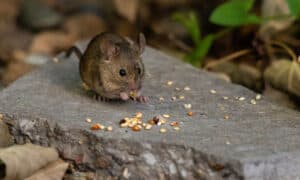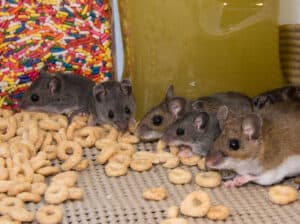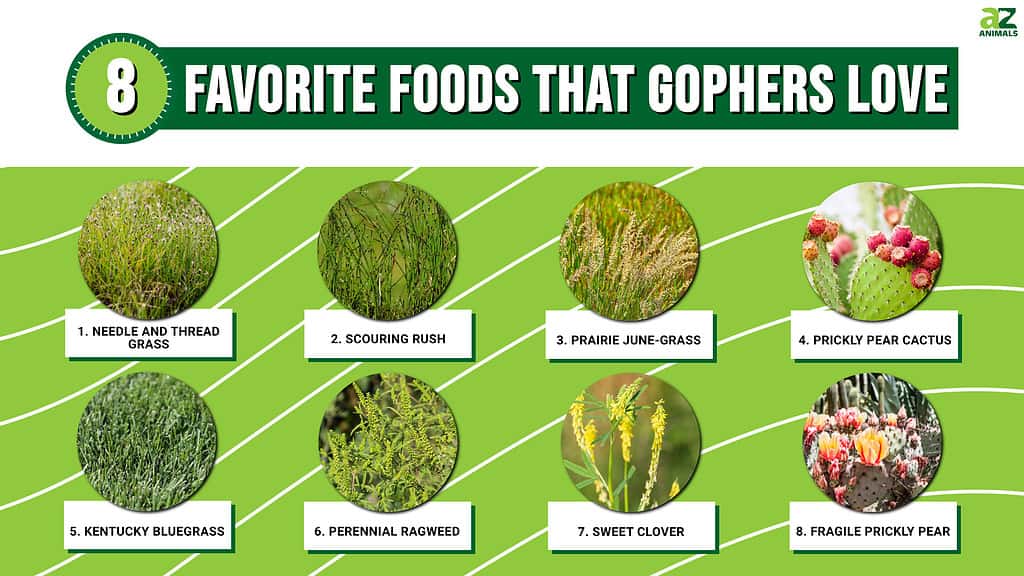
Have you ever wondered what these furry little herbivores called gophers eat? In a field of native grasses and weeds, gophers can be beneficial for the soil as they help to aerate it and help maintain a healthy diversity of plants. If you are a gardener, you may be less enamored of gophers as they also enjoy dining on lettuce, cabbage, potatoes, carrots, etc. One thing they do not like is castor oil so it can be used to deter gophers from your garden. Sawdust soaked in castor oil and sprinkled around your plants can help keep these critters out of your garden.
Read on to learn all about their favorite grasses and plants.
What Is a Gopher?
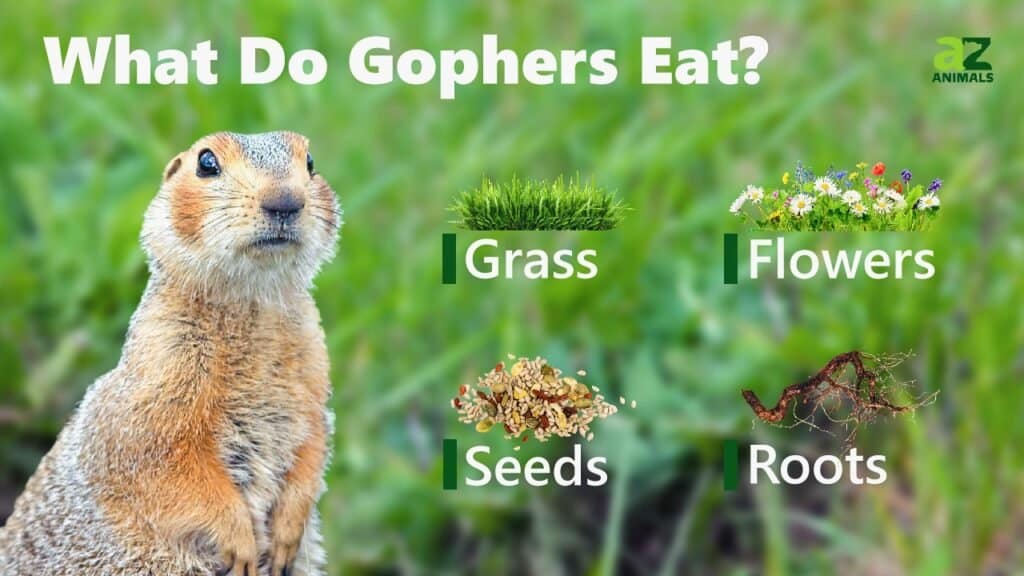
Gophers are small rodents who are members of the Geomyidae family. They are related to the kangaroo rat and pocket mouse. Although they are sometimes confused with groundhogs and prairie dogs, there are key differences between all those rodent species.
Gophers are fossorial, which means they spend most of their time underground. They eat, mate, and sleep in their burrows. Groundhogs and prairie dogs also build burrows, but they spend most of their time above ground. They only use their burrows to stash food and hide from predators.
Gophers are also much smaller than groundhogs. The average gopher weighs about 2 pounds, while a groundhog weighs about 15 pounds.
Is a Gopher the Same as a Pocket Gopher?
Yes, they are different names for the same animal. They’re not called that because they’re small enough to fit in a pocket, although it’s understandable why you might think that. In fact, they get that name from the pouches or pockets on their faces. They use these pockets to carry large quantities of food.
This brings us to our next question.
What Does a Gopher Eat?
Gophers mostly eat grasses and forbs. Forbs are a family of wild plants that have broad leaves and herbaceous stalks. Some examples of forbs are sunflowers, spiny asters, goldenrods, watercress, and hyssop. Most forbs flower, but they are not shrubs.
Gophers are herbivores who live on plants, flowers, and plant matter. They occasionally eat lettuce, carrots, and other vegetables, but they rarely eat seeds or fruits.
Researching Gopher Food Habits
In a study of gophers in eastern Colorado, researchers found that 64% of the gopher’s diet was grass. They also found that forbs were a favorite gopher food in the spring and summer when these plants are succulent.
The researchers broke down the grasses by the percentage they made up of the gopher’s diet. The grasses they ate the most were:
- Needle and thread grass (22%).
- Scouring rush (14%).
- Mosquito grass. (12%)
- Eastern prickly pear cactus (9%).
In another study of pocket gophers in Nebraska, the scientists studied the animals’ eating habits over three years. There, too, they found that needle and thread and scouring rush were the main food sources.
Grasses were almost half of what gophers in that region ate. Those same gophers, however, showed a strong preference for other grasses that were available in the spring and summer.
Among the forbs and grasses that gophers liked best were perennial ragweed (Ambrosia phyllostachya), sweet clover (Melilotus sp.), and fragile prickly pear (Opuntia fragilis).

©eumates/Shutterstock.com
What Are a Gopher’s Favorite Foods?
- Needle and thread grass (Hersperostipa comata) is a perennial grass that grows in bunches and is suited to dry, sandy soils. It is a type of needlegrass that looks like a dry, tangled beard. Needle and thread grass is considered a critical range species. This grass can grow up to 4 feet. It is one of the most commonly used grasses in land reclamation and rehabilitation.
- Scouring rush (Equisetum hyemale affinis) is a grass native to North America that looks like long, green reeds. It grows wild on rangelands and is suited to hot, sunny climates. It grows in dunes, open wooded areas, roadside ditches, and pastures. A scouring rush is a horsetail plant that develops dense clusters on its stems. In the past, people used these rough, thick clusters as scouring pads. That’s where the plant gets its common name.
- Mosquito grass (Bouteloua gracilis) is a small grass that is native to the central states of the U.S. It is a delicate grass known for its graceful, striped leaves. It is often grown as an ornamental plant, but in the wild, it is an important food source. It grows well in poor, dry soils and has striped blue and gray leaves. It produces small purple flowers in the summer.
- Eastern prickly pear cactus (Opuntia humifusa) is a flowering succulent with striped leaves. It has the largest range of any cactus species in the U.S. It grows on dry, open ground and can withstand extreme hot and cold temperatures. You can find it in hedgerows, rocky outcrops, and dunes. In the Nebraska study, the researchers found that prickly pear cactus was the most important food source for gophers in the Midwest.
- Prairie junegrass (Koeleria macrantha) is a native grass that grows well in dry, sandy environments. It is a tall plant with buds that are sometimes striped red and green. It is common in prairies. This grass is often used to reclaim land and stop soil erosion. Prairie junegrass is an important food source for many animals. It is a perennial that flowers in June and July.
- Kentucky bluegrass (Poa pratensis) is a slow-growing grass native to the northeastern states of the U.S. It is commonly found in pastures. It tolerates frequent grazing and many soil and weather conditions. The flavor of Kentucky bluegrass is a favorite among many animals, especially free-ranging cattle animals. It is named for the bluish-green color of its leaves.
Complete List of 8 Foods a Gopher Eats
| Number | Plant |
|---|---|
| 1. | Needle and thread grass |
| 2. | Scouring rush |
| 3. | Prairie June-grass |
| 4. | Prickly pear cactus |
| 5. | Kentucky bluegrass |
| 6. | Perennial ragweed |
| 7. | Sweet clover |
| 8. | Fragile prickly pear |
Who Are a Gopher’s Predators?
Gophers are prey for larger carnivores, including coyotes, bobcats, and snakes. Sometimes, raptors like owls and hawks will hunt gophers.
Do Gophers Hunt for Prey?
No, they don’t. Some researchers have found insects in gophers’ diets, but they may be eating them accidentally when they munch on grass. There’s no evidence that they hunt insects.
What Do Gophers Hate the Most?
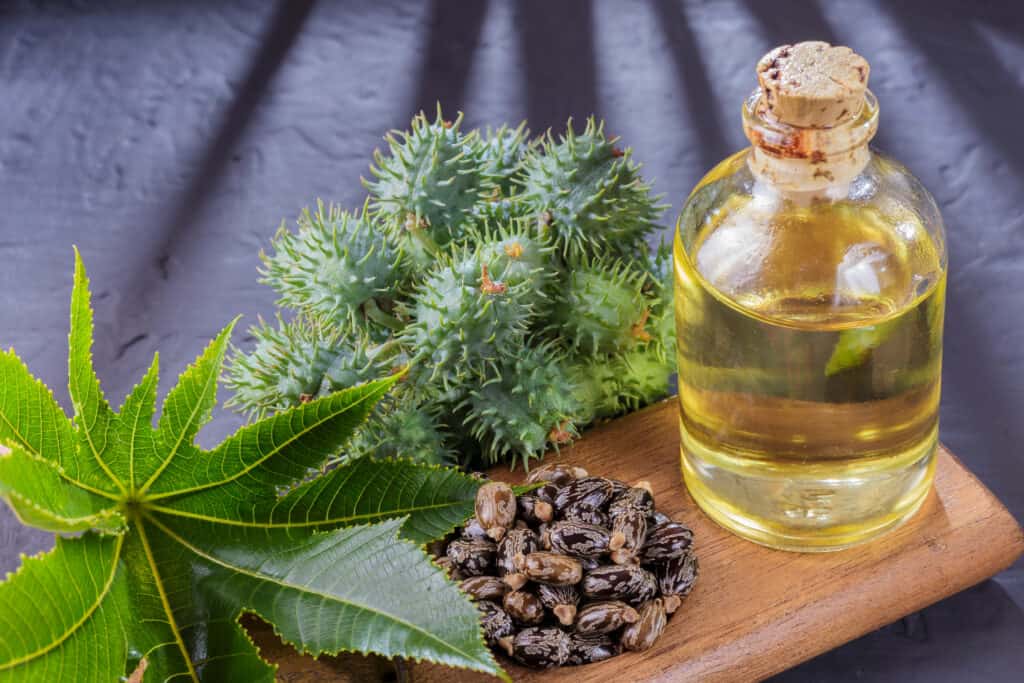
Castor oil is thought to be an effective way of ridding your yard of gophers.
©Alexander Ruiz Acevedo/Shutterstock.com
Gophers do not have good eyesight, it is said to be terrible, which may be why they have such a well-developed sense of smell. As a result of this, they are not in favor of smells that are extremely strong, which can irritate them. If you wish to keep these pesky critters out of your gardens or yards, these are some of the scents that you may want to include:
- Eucalyptus
- Geraniums
- Lavender
- Rosemary
- Sage
Another option is castor oil which also has a strong odor that they find offensive and and is easy to make at home. This homemade remedy is created using three parts castor oil to one part dish soap and adding it to one gallon of water. You will then need to spray the mixture around gopher tunnels and entrances, which may be a sure way of evicting them from your property.
The photo featured at the top of this post is © eumates/Shutterstock.com
FAQs (Frequently Asked Questions)
Are gophers carnivores, herbivores or omnivores?
They are herbivores. Studies have found that gophers can survive on a diet of just grasses, although they prefer to mix in some forbs and other flowering plants.
Are gophers friendly?
These little guys may be cute, but they are not friendly. Gophers are afraid of larger animals, including humans, and they are likely to hide in their burrows if they see one of us approaching.
Thank you for reading! Have some feedback for us? Contact the AZ Animals editorial team.




